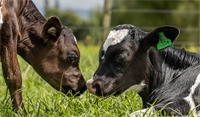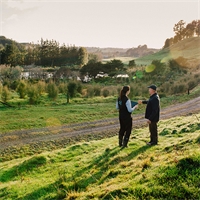Words by Craig Rodgers, Group Manager On-Farm Sales
Autumn is on its way following a summer that took a while to warm up but then delivered some hot dry periods in January. February has been a mixed bag with some autumn like conditions. Moisture reserves over late January and early February disappeared and soil temperatures remained high, putting some stress on pasture growth. Apart from a couple of spells of drier weather, the harvest took some time to gather momentum and for a period in mid-February. The cooler nights and morning meant minimal harvest completed during some days. Some areas also experienced cloudier than usual mornings and crops struggled to be ready in the afternoon periods.
Cultivation and drilling of pasture and autumn sown crops are underway with the long-term forecast through March looking good for regular rainfall, and if sunshine hours and soil temperature remain positive these crops should establish well.
Pasture
The warmer weather through the summer has seen pastures perform well in general. The soil temperature has remained at optimal levels meaning consistent grass growth. There has been minimal surplus of grass throughout the summer and some re-grassing programmes have been pushed into the autumn period. Older pastures have struggled on the extreme hot days and as they thin out, older types and weeds return in the gaps. This is a good time of year to identify paddocks for your re-grassing programme and these decisions should be made around production at key times of year to suit your farm. Selection of cultivars is also important and while there can be a variation in pricing the latest updated release of the Forage Value Index is a great guide to selecting the grass that will produce best when you need it to, check it here. Most new pastures will look good in the first couple of years, but persistence is where you get the greatest value. Cropping rotations also need to be considered as some short-term grasses can produce some very good yields and give paddocks a break from crops. While most grasses are bred to produce good yields in suitable conditions it has become obvious that not all grasses suit all farmers or the management style you may have on your farm. Establishment is also important and ensure a good spray programme is in place to remove any competition prior to drilling and once the pasture has struck.
Cereals & Grain
We are getting through the harvesting of cereal crops in some areas and at this stage yields seem to be down a little on last year. Once again there is a wide range of screenings across samples, especially for barley.
Grain prices are very static, and we may see a wide range of pricing across samples as quality will be a deciding factor for buyers. Demand has been minimal from dairy farmers and other end users due to feed surpluses in some areas and a reduction in stock numbers. Once again, we await results from some new varieties that entered the commercial market over the past year and while not all were available on the open market FAR will be updating results from trials to see if they can consistently perform over a period of time.
Grass Seed & Clover
While most harvested crops are currently being dressed once again there has been some very good grass seed yields across a variety of areas, early confirmed test results are encouraging and there should be plenty of availability across proprietary and common lines. Pricing has held up over the latter part of last year, and demand remains steady, especially for Nui.
The clover harvest is only just underway and most struggled with too much growth and bulk through the early summer. The hotter weather in January and February has helped them turn quicker than expected and if this weather continues through March, we should get the bulk of it harvested. It is unknown how the weather conditions have affected clover crops and we will only know once dressing is completed. The commodity clover price has been very dormant of late but still sitting at good price currently.
Fodder Beet
Fodder Beet crops are looking pretty good and have responded to the sun and warm soil temperatures this season. At this stage they seem on track with the previous seasons, however some were slow getting going due to the late spring but have responded well to Urea applications. Once again, we are starting to see some yellowing with the bottom leaves starting to drop off and some drooping on the extremely hot days. As the days get shorter and cooler, they should manage to grow through this, and the bulb will continue to develop in size. While it is too early to estimate yields it will be interesting to see how the earlier grazed crops perform. Some farmers are looking to transition and feed as early as April and we may see some variation across paddocks from commencement to the end of grazing as the crop continues to grow in April and May. Performance of varieties remains a good talking point and we will hear the usual yield estimations over the coming months, however the best way to get an accurate as possible yield calculations is to use an independent feed assessor even if the crop is for your own use. This will help the transitioning process and welfare of animals in the early grazing stages.
Catch Cropping
We have noticed an increase in enquiries for oats and other catch crop products following winter grazing, and the harvesting of crops in a period where historically we have left ground fallow.
Catch crops are used to cover the fallow ground and take up the urinary N deposited during winter grazing, reducing the risk of nitrate leaching. The use of catch cropping is a valuable tool to aid farmers to meet new requirements with environmental rules that are currently being implemented throughout the country.
Recent research from Forages for Reduced Nitrate Leaching (FRNL) and Pastoral 21 (P21) have shown dry matter (DM) production can be significantly increased at a lower cost per kg/DM while decreasing the amount of leachable N. One study has shown that by sowing catch crops such as oats following winter crop grazing, nitrogen losses have been reduced by up to 49% compared to leaving the ground fallow. The magnitude of this effect may vary depending on crop management, the chosen catch crops performance, soil type and seasonal weather conditions.
Related

Calving can be an exciting time of year, with lots of calves around and milk starting to flow into t...
Read More

“Water is the forgotten source of bacteria and pathogens on your farm.”
Read More

A cutting-edge software tool is helping farmers reduce losses.
Read More

From an under-resourced dryland sheep farm to a highly productive mixed cropping operation, Valetta ...
Read More

Today marked Ruralco’s 60th anniversary, and this significant milestone was celebrated at the ...
Read More

Once home to one of the country’s leading red deer herds, Mark and India van der Wilt have put Bang...
Read More